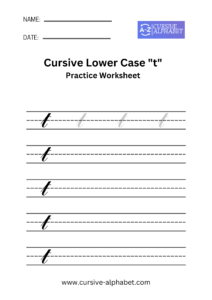Lowercase Alphabet t
Cursive handwriting is a valuable skill that remains relevant and widely used today. While it may be considered outdated by some, the benefits of learning cursive handwriting are numerous. One of the letters that can be challenging to master is the lowercase cursive alphabet t. In this article, we will explore the structure and techniques for mastering this letter.
Basic Structure of Lowercase Cursive Alphabet t
The lowercase cursive alphabet t is written with a single stroke that starts at the top and curves to the right. The stroke then loops down and to the left before finishing with a short upward stroke. Connecting letters to t is relatively simple, as it usually connects to the letter a or a following letter such as i or e.
There are a few common variations of t in cursive handwriting. Some writers prefer to cross the t with a long tail, while others prefer a short tail or no tail at all.
Tips for Practicing Lowercase Cursive t
Proper hand positioning and posture are crucial for comfortable and accurate handwriting. When practicing lowercase cursive alphabet t, make sure your hand and wrist are positioned correctly. Your hand should be relaxed, and your wrist should be straight and not bent.
Using guidelines and tracing exercises can also be helpful when learning how to write lowercase cursive alphabet t. Tracing over letters or using lined paper can help you maintain consistency in your writing.
Practicing consistently and regularly is also essential for developing your cursive handwriting skills. Try to set aside some time each day to practice writing lowercase cursive alphabet t, whether it be a few minutes or a full writing session.
Creative Ways to Practice
Writing short sentences using t and other letters is an excellent way to practice the lowercase cursive alphabet t. You can also try tracing and copying famous quotes or song lyrics, as this can help you develop your skills while also providing some inspiration.
Another creative way to practice is by designing and writing personal notes or letters. Not only does this help you practice your handwriting, but it also allows you to express yourself and connect with others in a meaningful way.
Troubleshooting Common Problems
Common mistakes when writing lowercase cursive alphabet t include not starting the stroke from the top or not curving the tail of the letter properly. To fix these mistakes, focus on maintaining the correct stroke order and direction.
To improve consistency and legibility, try practicing with different writing tools, such as pens or pencils. Experiment with the pressure you use when writing, as this can also impact the appearance of your handwriting.
If you experience hand fatigue or discomfort when practicing, take breaks regularly and stretch your hands and wrists. If the discomfort persists, consider adjusting your writing position or consulting a healthcare professional.
Conclusion
Learning the lowercase cursive alphabet t can be challenging, but ultimately rewarding. Mastering this letter can improve your overall cursive handwriting skills and provide a sense of accomplishment. You can refine your abilities and keep making progress with your handwriting by using the methods and suggestions in this article and putting them into regular practice. Keep practicing your cursive handwriting, and soon you will have beautiful and legible handwriting.
